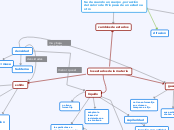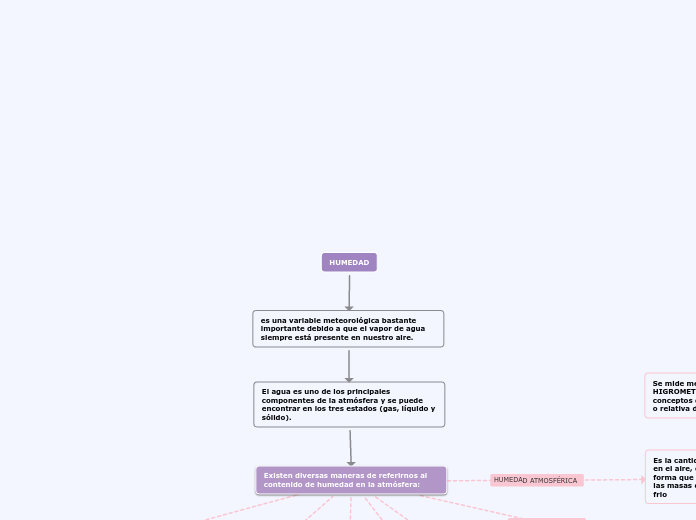Disoluciones/ Concentración y Solubilidad.
Learn more about hurricanes and tornadoes, the areas of the world they affect, how they are formed and when, and what you can do to survive such an extreme storm.
Disoluciones.
Mayor superficie de contacto, más rápido.
Research on the emergency procedures and safety tips that can keep you safe before, during and after a hurricane.
Debido a que hay un mayor numero de partículas entre ambos interaccionando.
List several safety tips that will help you cope with the situation after the hurricane has left your area.
El aumento de temperatura, acelera el proceso debido a
How do hurricanes form?
Watch the video then type in a short explanation of how the hurricanes are formed.
Mas separadas estarán las partículas de disolvente por un lado y las de soluto por otro
Mayor agitacion particulas de los 2 componentes
Tres tipos de interacciones.
The classification system for hurricanes is called The Saffir-Simpson Hurricane Wind Scale, and it's a 1 to 5 categorization of the hurricane's intensity at the indicated time.
Each category expresses the intensity in miles per hour. Example: category 1 (74-95 mph).
Type in the other 4 categories.
Soluto-Disolvente
Disoovente-Disolvente
Soluto-Soluto
Proceso de la disolución según la TMC (3 etapas)
Fase 3; Las partículas del soluto se dispersan entra las del disolvente
Fase 2; Las partículas del disolvente se separan.
Fase 1; Las particulos del soluto se separan.
Componentes de una disolución.
Which are the areas/countries of the world hit most frequently or severely by hurricanes? Choose from the options below or add your own.
ChinaPhilippinesGrand CaymanJapanAustraliaUnited StatesCaribbeanMexicoTaiwanVietnamAtlantic CoastOther
Si la disolución es en agua; el agua es el disolvente.
Soluto: sustancia que se disuelve, - proporción.
Type in the two official seasons from the Atlantic and Pacific.
Disolvente: medio en el cual se disuelve la otra sustancia, + proporción
¿Qué es?
Hurricanes are the most violent, swirling storms on Earth, with winds that can go up to 259 kilometers per hour.
A hurricane's forming elements:
- Eye- the "hole" at the center of the storm where the winds are lighter and the skies are only partly cloudy
- Eye wall- the ring of thunderstorms that are swirling around the eye. This is where the winds are the strongest and rain the heaviest.
- Rain bands -that expand from the eye wall
Una mezcla homogenea esta compuesta por varias sustancias puras las cuales no reaccionan entre si. Cuando el tamaño de las particulas no se puede distinguir
Concentración y solubilidad.
Solubilidad
Tornadoes that have been known throughout history
Experimental podemos comprobar:
Ley de Henry: la solubilidad de un gas en un liquido a temperatura constante es directamente proporcional a la presión parcial del gas sobre la disolucion.
Solubilidad de un gas en un liquido disminuye siempre con la temperatura.
Solubilidad de un solido en un liquido aumenta con la temperatura.
La solubilidad de un soluto en un disolvente es la máxima cantidad de soluto que admite ese disolvente; la concentración de la disolución saturada de dicho disolvente en ese disolvente concretp
Concentración
Tornadoes are local storms of short duration (this ranges between 5 and 10 minutes) formed of winds that rotate at very high speeds, usually in a counter-clockwise direction.
A tornado's characteristics:
- Time of day: they usually occur in the afternoon (3 - 7 PM)
- Direction: usually from southwest to northeast
- Length of path: this is the distance it travels; the average is 4 miles, but it could also travel around 300 miles.
- Width of path: averages between 300 and 400 yards but tornadoes have cut paths a mile or more in width.
- Speed of travel: though speeds of 68 mph have been reported, the average speed is somewhere between 25 and 40 mph.
- Cloud: dark cumulonimbus (thunderstorm cloud) from which the funnel-shaped pendant extends to the ground.
- Precipitation: rain and hail before the tornado hits and heavy downpour to the side of the tornado's path.
- Sound: roaring, rushing noise.
Fracción molar.
Research on the emergency procedures and safety tips that can keep you safe before, during and after a hurricane. Type in several of them.
La fracción molar del soluto/del disolvente. Es la cantidad de sustancia que de cada uno de ellos
List several emergency procedures and safety tips that will prepare you for a tornado.
X soluto +X disolvente = 1
X disolvente = n disolvente / n soluto+ n disolvente.
X soluto = n soluto/ n soluto+ n disolvente.
Molalidad
Tornadoes are the most violent storms on Earth
Watch the video then type in a short explanation of how the tornadoes are formed.
Es la cantidad de soluto que hay en cierta masa de disolvente.
m= n soluto/ m disolvente= m soluto / M(SOLUTO) x m disolvente.
Molaridad
The classification system for tornadoes is called The Fujita Scale (or F scale), and it's an F0 to F6 categorization of the tornado's intensity.
Each category expresses the intensity in miles per hour.
Example: category F0 (40–72 mph; includes damages to trees, chimneys, and billboards).
Type in the other 5 categories.
Expresa la canitdad de soluto que hay en un volumen de un disolvente
M= n soluto/v disolución.
Concentración en masa.
Tornadoes can occur almost all over the world, but US's unique geography makes it the ideal place for their development.
Type in the tornado seasons in the United States, taking into account the
Southeast and Northern Plains regions.
Es la masa de soluto que hay en un volumen de disolucion
c= m soluto/v disolución
Porcentajes en masa y volumen.
Which are the areas/countries of the world hit most frequently or severely by tornadoes? Choose from the options below or add your own.
North AmericaEuropeSouth AfricaPhilipppinesBangladeshNew ZealandSouth AmericaCanadaOther
Porcentaje en volumen.
Volumen de soluto que hay en un volumen de disolución, expresado en tanto por cien
%(volumen)=(v soluto/v disolución)100
Porcentaje en masa.
Masa de soluto que hay en una masa de disolución, expresado en tanto por cien
%(masa)=(m soluto/m disolución)100
La concentración de una disolución es la cantidad de soluto disuelta em uma cantidad dada de disolvente o de disolución









